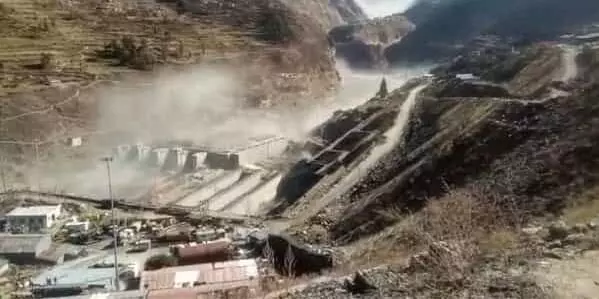
Uttarakhand glacier burst: Climate change and human activities the reasons, says experts
text_fieldsWhat caused the glacier burst disaster in Uttarakhand that has led to the death of scores of people with 200 missing in the hill state?
The geological expert team who visited the disaster site say that it is still too early to pinpoint a precise reason behind the disaster but opined both climate change and human activities could have triggered it.
Uttarakhand, India's northern state, crossed by the Himalayas, falls under the Zone-IV and V of India's earthquake risk map. The region is fragile, prone to earthquakes and has witnessed similar disasters in the past as well.
Stone quarrying, blasting of mountains, digging of tunnels at the base of fragile mountains, deforestation in the upper reaches of Central Himalayas for building hydropower plants and construction of wide roads by disregarding environmental norms have all been identified as triggers.
The fragile upper reaches of Uttarakhand already have numerous dams with more under construction. Experts claim climate change can make these areas more fragile, and the construction of such power plants in these areas will only welcome more disasters in the future.
On Sunday's flash flood, the water raging through the gorge crashed into the Rishiganga hydroelectric dam located on the upper stream of Alakananda and within the areas of Nanda Devi Reserve Biosphere. The debris from this dam along with the water, has caused severe damage to many other hydro plants as well.
Scientists say such incidents are only set to become more common if no immediate action is taken against the worsening climate change situation. Winter is regarded as a safe time for glaciers as they remain frozen and rigid, but these glaciers become active as the summer season begins.
A 2019 survey that showed Himalayan glaciers melting at an alarming rate had warned about the large-scale devastation this can have on the nearby areas. The study, published in the journal Science Advances in June 2019, revealed that glaciers have been losing the equivalent of more than a vertical foot and half of the ice each year since 2000.
Climate change and the disproportionate building of dams on fragile ecosystems had also caused the infamous Kedarnath disaster in Uttarakhand back in 2013 when the banks of the Chorabari Lake in Kedarnath collapsed due to a cloudburst resulting in the death of approximately 6000 people. The two disasters had taken place in the same district in less than a decade's span.
























